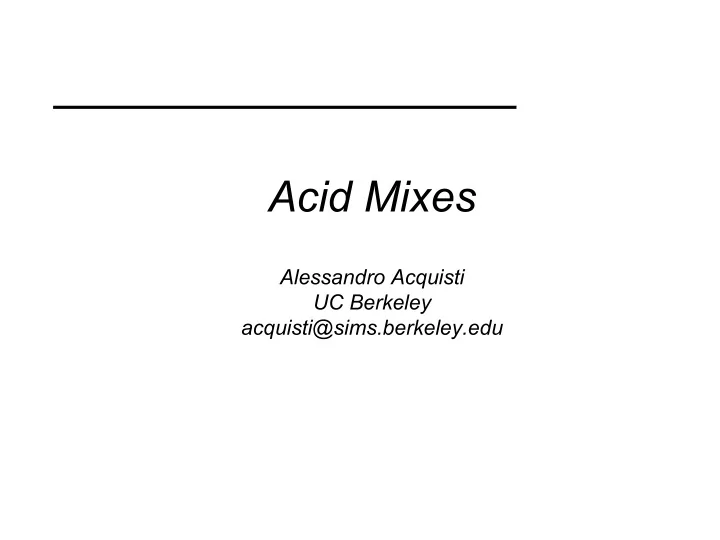

Acid Mixes Alessandro Acquisti UC Berkeley acquisti@sims.berkeley.edu
What is that? • A variation on mix-net protocols that (attempts to) address reliability and trust issues while maintaining anonymity and preserving ACID properties. • The variation is, itself, a “mix”: • Chaum (1981): mix-nets. • Chaum (1991): group signatures. • Stajano and Anderson (1999): cocaine auction protocol. • Applications: flexible, but more efficient in targeted communications. For example: • Voting systems. • Payments.
Vanilla mix-net Senders Recipients Mixer (trusted)
Issues discussed in the literature • Trust. • Reliability. • Often, trade-offs between the two.
Vanilla acid mix Senders Recipients Mixer (untrusted)
More precisely… • Let users interact… • ...through untrusted third party (mix)… • …splitting information… • …and broadcasting it.
Analysis • Compare to Chaum (1981) voting mix-net protocol: • Candidate sends identification+key (pseudonym) through mix-net, then votes. • Here: • Identification sent separately from key. • Mixed through other users. • How? • Stajano and Anderson (1999). Message 3. can be broadcasted anonymously – does not contain identifying information (or, see Pfitzmann and Waidner [1986]).
Strengths, weaknesses, and attacks • Strengths – Untrusted third party. – Untrusted senders. – Flexible. • Weaknesses – Efficiency (depending on application). • Attacks – Intersection attack. – Adversary observes in/out communication and owns some senders: OK. – Adversary sees in/out communication and owns all senders (“n-1 attack”): Not OK.
Applications • (Messaging) • Payments • Sender/buyer unlinkabilty. • Voting • Receipt free. • Universally verifiable. • Open-ended ballot question. • (caveats.)
For the record
acquisti@sims.berkeley.edu
Recommend
More recommend